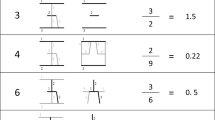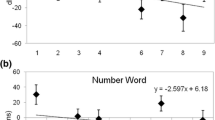Abstract
As previously reported (Beran and Rumbaugh, 2001), two chimpanzees used a joystick to collect dots, one-at-a-time, on a computer monitor, and then ended a trial when the number of dots collected was equal to the Arabic numeral presented for the trial. Here, the chimpanzees were presented with the task again after an interval of 6 months and then again after an additional interval of 3.25 years. During each interval, the chimpanzees were not presented with the task, and this allowed an assessment of the extent to which both animals retained the values of each Arabic numeral. Despite lower performance at each retention interval compared to the original study, both chimpanzees performed above chance levels in collecting a quantity of dots equal to the target numeral, one chimpanzee for the numerals 1–7, and the second chimpanzee for the numerals 1–6. For the 3.25-year retention, errors were more dispersed around each target numeral than in the original study, but the chimpanzees' performances again appeared to be based on a continuous representation of magnitude rather than a discrete representation of number. These data provide an experimental demonstration of long-term retention of the differential values of Arabic numerals by chimpanzees.



Similar content being viewed by others
Notes
These chimpanzees have shown similar signs of using an analog mechanism in more spontaneous tasks of numerousness judgments (e.g., Beran 2001). However, it should be noted that variability as a function of set size is not seen in studies in which "responsive" enumeration occurs as when visible sets are matched with a specific numerical symbol (see Beran and Rumbaugh 2001, for further description; see also Matsuzawa 1985; Boysen and Berntson 1989; Pepperberg 1994; Xia et al. 2000, 2001) or in some studies of numerousness judgments (Hauser et al. 2000; but see Call 2000; Beran 2001, 2003).
References
Alsop B, Honig WK (1991) Sequential stimuli and relative numerosity discriminations in pigeons. J Exp Psychol Anim Behav Process 17:386–395
Anderson JR, Awazu S, Fujita K (2000) Can squirrel monkeys (Saimiri sciureus) learn self-control? A study using food array selection tests and reverse-reward contingency. J Exp Psychol Anim Behav Process 26:87–97
Bahrick HP (1984) Semantic memory content in permastore memory: fifty years of memory for Spanish learned in school. J Exp Psychol Gen 113:1–26
Balda RP, Kamil AC (1992) Long-term spatial memory in Clark's nutcrackers, Nucifraga columbiana. Anim Behav 44:761–769
Balda RP, Wiltscheko W (1995) Spatial memory of homing pigeons, Columbo livia , tested in an outdoor aviary. Ethology 100:253–258
Bednekoff PA, Balda RP, Kamil AC, Hile AG (1997) Long-term spatial memory in four seed-caching corvid species. Anim Behav 53:335–341
Beran MJ (2001) Summation and numerousness judgments of sequentially presented sets of items by chimpanzees (Pan troglodytes). J Comp Psychol 115:181–191
Beran MJ (2002) Maintenance of self-imposed delay of gratification by four chimpanzees (Pan troglodytes) and an orangutan (Pongo pygmaeus). J Gen Psychol 129:49–66
Beran MJ (2003) Chimpanzees (Pan troglodytes) respond to nonvisible sets after one-by-one addition and removal of items. J Comp Psychol (in press)
Beran MJ, Beran MM (2003) Chimpanzees remember the results of one-by-one addition of food items to sets over extended time periods. Psychol Sci (in press)
Beran MJ, Minahan MF (2000) Monitoring spatial transpositions by bonobos (Pan paniscus) and chimpanzees (P. troglodytes). Int J Comp Psychol 13:1–15
Beran MJ, Pate JL, Richardson WK, Rumbaugh DM (2000) A chimpanzee's (Pan troglodytes) long-term retention of lexigrams. Anim Learn Behav 28:201–207
Beran MJ, Rumbaugh DM (2001) "Constructive" enumeration by chimpanzees (Pan troglodytes) on a computerized task. Anim Cogn 4:81–89
Beran MJ, Washburn DA (2002) Chimpanzee responding during matching-to-sample: control by exclusion. J Exp Anal Behav 78:497–508
Beran MJ, Rumbaugh DM, Savage-Rumbaugh ES (1998) Chimpanzee (Pan troglodytes) counting in a computerized testing paradigm. Psychol Rec 48:3–19
Beran MJ, Savage-Rumbaugh ES, Pate JL, Rumbaugh DM (1999) Delay of gratification in chimpanzees (Pan troglodytes). Dev Psychobiol 34:119–127
Biro D, Matsuzawa T (2001) Use of numerical symbols by the chimpanzee (Pan troglodytes): cardinals, ordinals, and the introduction of zero. Anim Cogn 4:193–199
Boysen ST, Berntson GG (1989) Numerical competence in a chimpanzee (Pan troglodytes). J Comp Psychol 103:23–31
Boysen ST, Berntson GG (1995) Responses to quantity: perceptual versus cognitive mechanisms in chimpanzees (Pan troglodytes). J Exp Psychol Anim Behav Process 21:82–86
Boysen ST, Capaldi EJ (1993) The development of numerical competence: animal and human models. Comparative cognition and neuroscience. Erlbaum, Hillsdale, N.J.
Brannon EM, Terrace HS (1998) Ordering of the numerosities 1 to 9 by monkeys. Science 282:746–749
Burdyn LE, Noble LM, Shreves LE, Thomas RK (1984) Long-term memory for concepts by squirrel monkeys. Physiol Psychol 12:97–102
Burns RA, Goettl ME, Burt ST (1995) Numerical discriminations with arrhythmic serial presentations. Psychol Rec 14:3–17
Call J (2000) Estimating and operating on discrete quantities in orangutans (Pongo pygmaeus). J Comp Psychol 114:136–147
Capaldi EJ, Miller DJ (1988) Counting in rats: its functional significance and the independent cognitive processes that constitute it. J Exp Psychol Anim Behav Process 14:3–17
Clayton NS, Dickinson AD (1998) What, where and when: evidence for episodic-like memory during cache recovery by scrub jays. Nature 395:272–274
Clayton NS, Dickinson AD (1999a) Memory for the content of caches by scrub jays. J Exp Psychol Anim Behav Process 25:82–91
Clayton NS, Dickinson AD (1999b) Scrub jays (Aphelocoma coerulescens) remember when as well as where and what food items they cached. J Comp Psychol 113:403–416
Davis H, Bradford SA (1986) Counting behavior by rats in a simulated natural environment. Ethology 73:265–280
Davis H, Bradford SA (1991) Numerically restricted food intake in the rat in a free-feeding situation. Anim Learn Behav 19:215–222
Davis H, Perusse R (1988) Numerical competence in animals: definitional issues, current evidence, and a new research agenda. Behav Brain Sci 11:561–615
Dooley GB, Gill T (1977) Acquisition and use of mathematical skills by a linguistic chimpanzee. In: Rumbaugh DM (ed) Language learning by a chimpanzee. Academic, New York, pp 247–260
Emmerton J (1998) Numerosity differences and effects of stimulus density on pigeons' discrimination performance. Anim Learn Behav 26:243–256
Emmerton J, Lohmann A, Niemann J (1997) Pigeons' serial ordering of numerosity with visual arrays. Anim Learn Behav 25:234–244
Ferster CB (1964) Arithmetic behavior in chimpanzees. Sci Am 210:98–106
Gallistel CR, Gelman R (2000) Non-verbal numerical cognition: from reals to integers. Trends Cogn Sci 4:59–65
Gleitman H (1971) Forgetting of long-term memories in animals In: Honig WK, James PHR (eds) Animal memory. Academic, New York, pp 1–44
Griffiths DP, Clayton NS (2001) Testing episodic memory in animals: a new approach. Physiol Behav 73:755–762
Griffiths D, Dickinson A, Clayton N (1999) Episodic memory: what can animals remember about their past? Trends Cogn Sci 3:74–80
Hauser MD, Carey S, Hauser LB (2000) Spontaneous number representation in semi-free-ranging rhesus monkeys. Proc R Soc Lond B Biol Sci 267:829–833
Honig WK, Stewart KE (1989) Discrimination of relative numerosity by pigeons. Anim Learn Behav 17:134–146
Insley SJ (2000) Long-term vocal recognition in the northern fur seal. Nature 406:404–405
Johnson CK, Davis RT (1973) Seven-year retention of oddity learning set in monkeys. Percept Mot Skill 37:920–922
Koehler O (1951) The ability of birds to count. Bull Anim Behav 9:41–45
Köhler W (1925) The mentality of apes. Liveright, New York
MacDonald SE (1994) Gorillas' (Gorilla gorilla gorilla) spatial memory in a foraging task. J Comp Psychol 108:107–113
Machado A, Keen R (2002) Relative numerosity discrimination in the pigeon: further tests of the linear-exponential-ratio model. Behav Process 57:131–148
Matsuzawa T (1985) Use of numbers by a chimpanzee. Nature 315:57–59
Menzel CR (1991) Cognitive aspects of foraging in Japanese monkeys. Anim Behav 41:397–402
Menzel CR (1999) Unprompted recall and reporting of hidden objects by a chimpanzee (Pan troglodytes) after extended delays. J Comp Psychol 113:426–434
Menzel EW (1973) Chimpanzee spatial memory organization. Science 182:943–945
Mitchell RW, Yao P, Sherman PT, O'Regan M (1985) Discriminative responding of a dolphin (Tursiops truncatus) to differentially rewarded stimuli. J Comp Psychol 99:218–225
Murofushi K (1997) Numerical matching behavior by a chimpanzee (Pan troglodytes): subitizing and analogue magnitude estimation. Jpn Psychol Res 39:140–153
Patterson TL, Tzeng OJL (1979) Long-term memory for abstract concepts in the lowland gorilla (Gorilla g. Gorilla). B Psychonom Soc 13:279–282
Pepperberg IM (1987) Evidence for conceptual quantitative abilities in the African Grey Parrot: labeling of cardinal sets. Ethology 75:37–61
Pepperberg IM (1994) Numerical competence in an African Grey Parrot (Psittacus erithacus). J Comp Psychol 108:36–44
Reichmuth Kastak C, Schusterman RJ (2002) Long-term memory for concepts in a California sea lion (Zalophus californianus). Anim Cogn 5:225–232
Rensch B (1957) The intelligence of elephants. Sci Am 196:44–49
Roberts WA, Mitchell S (1994) Can a pigeon simultaneously process temporal and numerical information? J Exp Psychol Anim Behav Process 20:66–78
Roberts WA, Coughlin R, Roberts S (2000) Pigeons flexibly time or count on cue. Psychol Sci 11:218–222
Rumbaugh DM (1977) Language learning by a chimpanzee: the LANA project. Academic, New York
Rumbaugh DM, Steinmetz GT (1971) Discrimination reversal skills of the lowland gorilla (Gorilla g. gorilla) Folia Primatol 16:144–152
Rumbaugh DM, Savage-Rumbaugh ES, Hegel MT (1987) Summation in the chimpanzee (Pan troglodytes). J Exp Psychol Anim Behav Process 13:107–115
Rumbaugh DM, Hopkins WD, Washburn DA, Savage-Rumbaugh ES (1989) Lana chimpanzee learns to count by "Numath": a summary of a videotaped experimental report. Psychol Rec 39:459–470
Schusterman RJ (1988) Language and counting in animals: stimulus classes and equivalence relations. Behav Brain Sci 11:596–597
Schwartz BL, Evans S (2001) Episodic memory in primates. Am J Primatol 55:71–85
Schwarz M, Feldman E, Susswein AJ (1991) Variables affecting long-term memory of learning that a food is inedible in Aplysia. Behav Neurosci 105:193–201
Schwartz BL, Colon MR, Sanchez IC, Rodriguez IA, Evans S (2002) Single-trial learning of "what" and "who" information in a gorilla (Gorilla gorilla gorilla): implications for episodic memory. Anim Cogn 5:85–90
Shumaker RW, Palkovich AM, Beck BB, Guagnano GA, Morowitz H (2001) Spontaneous use of magnitude discrimination and ordination by the orangutan (Pongo pygmaeus). J Comp Psychol 115:385–391
Terrell DF, Thomas RK (1990) Number-related discrimination and summation by squirrel monkeys (Samiri sciureus sciureus) and (S. boliviensus boliviensus) on the basis of the number of sides of polygons. J Comp Psychol 104:238–247
Thomas RK, Fowlkes D, Vickery JD (1980) Conceptual numerousness judgments by squirrel monkeys. Am J Psychol 93:247–257
Tinklepaugh OL (1932) Multiple delayed reaction with chimpanzees and monkeys. J Comp Psychol 13:207–243
Tomonaga M, Matsuzawa T (2002) Enumeration of briefly presented items by the chimpanzee (Pan troglodytes) and humans (Homo sapiens). Anim Learn Behav 30:143–157
Washburn DA (1994) Stroop-like effects for monkeys and humans: processing speed or strength of association. Psychol Sci 5:375–379
Washburn DA, Rumbaugh DM (1991) Ordinal judgments of numerical symbols by macaques (Macaca mulatta). Psychol Sci 2:190–193
Winograd E (1971) Some issues relating animal memory to human memory In: Honig WK, James PHR (eds) Animal memory. Academic, New York, pp 259–278
Xia L, Siemann M, Delius JD (2000) Matching of numerical symbols with number of responses by pigeons. Anim Cogn 3:35–43
Xia L, Emmerton J, Siemann M, Delius JD (2001) Pigeons (Columba livia) learn to link numerosities with symbols. J Comp Psychol 115:83–91
Acknowledgements
This research was supported by National Institutes of Health Grant HD - 38051 to the Language Research Center of Georgia State University. The author thanks Charles Menzel and David Washburn for their comments on an earlier version of this paper. All applicable institutional rules and regulations regarding animal care and use have been followed in the care and testing of the chimpanzees, and the experiment complied with all laws of the United States of America.
Author information
Authors and Affiliations
Corresponding author
Rights and permissions
About this article
Cite this article
Beran, M.J. Long-term retention of the differential values of Arabic numerals by chimpanzees (Pan troglodytes). Anim Cogn 7, 86–92 (2004). https://doi.org/10.1007/s10071-003-0191-x
Received:
Revised:
Accepted:
Published:
Issue Date:
DOI: https://doi.org/10.1007/s10071-003-0191-x




